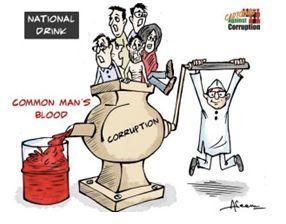 The statement by Mr. L. K. Advani, a leader of the Bharatiya Janata Party (BJP) that the country’s global image is at an all-time low is partially correct. It is reflected in manifold forms, including in the treatment Indians receive when they present their passport at the immigration counters in foreign nations and in the monstrous corruption that India is infamous for, globally. At a deeper and microscopic domestic level, it is reflected in the entrenched practice of caste and gender based discrimination, in the malnourished faces of millions of children who call India home and in the violence committed by the law enforcement agencies with impunity against Indians across the wide expanse of this nation with a rich cultural and intellectual history. However to blame any particular political party for this is mere cowardice and denying one’s own responsibility, a character Advani shares with most of the political leadership in India.
The statement by Mr. L. K. Advani, a leader of the Bharatiya Janata Party (BJP) that the country’s global image is at an all-time low is partially correct. It is reflected in manifold forms, including in the treatment Indians receive when they present their passport at the immigration counters in foreign nations and in the monstrous corruption that India is infamous for, globally. At a deeper and microscopic domestic level, it is reflected in the entrenched practice of caste and gender based discrimination, in the malnourished faces of millions of children who call India home and in the violence committed by the law enforcement agencies with impunity against Indians across the wide expanse of this nation with a rich cultural and intellectual history. However to blame any particular political party for this is mere cowardice and denying one’s own responsibility, a character Advani shares with most of the political leadership in India.
How could events like the 2002 Gujarat riots, the shameful remarks made against women by politicians like Mr. Narendra Modi and the corruption scam exposed against BJP’s own president place the BJP at a moral high ground than the Indian National Congress? In fact malnutrition is reported to be the highest in the country in all BJP or its allies-ruled states as well as in the state of West Bengal, which was until recently under the Communist rule. Is it not equally condemnable and criminal, the statement that was made by the incumbent external affairs’ minister against civil society activists, when allegations of corruption were made against his family business, that the minister claims to be a welfare organisation? Was it not the same intolerance of clinical criticism that prompted the government to register a concocted criminal charge against an activist like Mr. Aseem Trivedi? Haven’t all these contributed substantially to damage the country’s image?
What is at stake here is the dignity of every Indian. The country has an extremely poor human rights record. Out of the 193 member states at the United Nations, India is one of those countries that is yet to ratify all of the most important human rights treaties, more commonly known as “core human rights conventions”, for instance the Convention against Torture and Other Cruel, Inhuman or Degrading Treatment or Punishment and the International Convention on the Protection of the Rights of All Migrant Workers and Members of Their Families. Of the conventions India has ratified, it has opted out from the jurisdiction of the treaty body mechanisms, the Human Rights Committee and the Economic Social and Cultural Rights Committee for instance, to decide on individual complaints.
However, ratification of a convention or the number of conventions ratified is by no means to measure domestic human rights standards. Countries like Nepal, Sri Lanka and Cambodia are example to this.
At the core is a nation’s resolve to ensure dignity to its people. How could a country expect global dignity, when it fails to guarantee it to its own people? The concept of human dignity is built upon the bedrock of equality and freedom.
The constitution of India is a basic document that promises, to every Indian, dignity, based on equality and freedom. How could this solemn constitutional guarantee be realised without adequate internal mechanisms that are almost non-functional, most importantly justice institutions, taking within its sweep, the entire criminal justice apparatus? How many judges and prosecutors in India could claim that they are neither intellectually nor materially corrupt?
A country where torture is practiced with impunity is intellectually discordant with notions of fair trial, presumption of innocence and the very concepts of equality and dignity. Where fair trial is impossible, democracy cannot sustain. It is in such a country, massive and petty corruption, malnutrition and discrimination of all forms could survive, as it is in India at the moment. In such a quagmire of a nation, investment would be mere exploitation, and development exceptionally selective that will unjustifiably benefit only a few. It is in this context the statement issued by Standard and Poor that India’s sovereign credit rating may be cut to junk grade within two years if steps are not taken to check fiscal deficit and improve investment climate becomes relevant.
The responsibility to improve the dignity of a nation is upon its own people, more importantly upon its leadership. Is it not true that in India, a political leadership that is willing and capable to take head-on this challenge is almost absent? When a country is infamous for a substantial number of its legislators and a corrupt executive that trash the dignity, equality and freedom of its own people, how could the rest of the world treat it with dignity? How could such a country have a good global image?
Cartoon courtesy: Mr. Aseem Trivedi, Cartoonist, journalist and anti-corruption activist; www.cartoonsagainstcorruption.blogspot.in
For information and comments: Bijo Francis, AHRC. Telephone: + 852 – 26986 339, Email: india@ahrc.asia